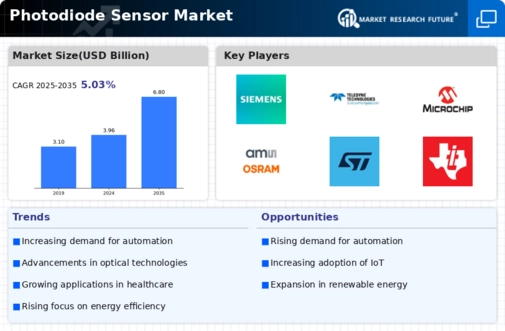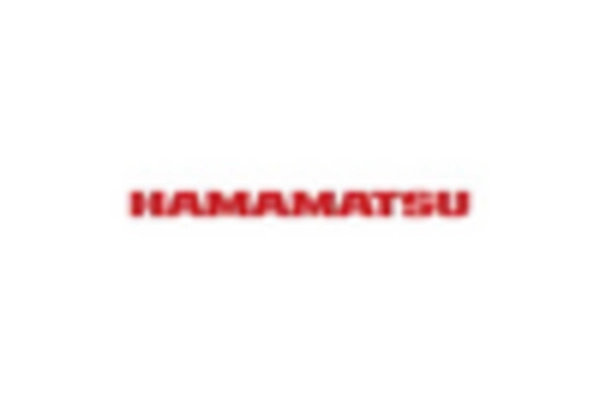Growth in Automotive Applications
The Photodiode Sensor Market is significantly influenced by the automotive sector, where the adoption of photodiode sensors is on the rise. These sensors are increasingly utilized in applications such as light detection for automatic headlight control and safety systems. The automotive industry is projected to witness a compound annual growth rate that could exceed 10% in the coming years, indicating a robust demand for photodiode sensors. As vehicles become more sophisticated with the integration of advanced driver-assistance systems (ADAS), the reliance on photodiode sensors is expected to grow. This trend suggests that the Photodiode Sensor Market will benefit from the automotive sector's shift towards enhanced safety and automation, potentially leading to increased production and innovation in sensor technologies.
Emergence of IoT and Smart Devices
The Photodiode Sensor Market is being propelled by the rapid emergence of Internet of Things (IoT) technologies and smart devices. As more devices become interconnected, the need for efficient and reliable sensors is paramount. Photodiode sensors are integral to various IoT applications, including smart lighting, environmental monitoring, and health tracking. The IoT market is projected to grow at a remarkable pace, potentially reaching trillions in value by 2025. This growth indicates a burgeoning demand for photodiode sensors, as they are essential for data collection and interaction in smart environments. Consequently, the Photodiode Sensor Market is likely to benefit from this trend, as manufacturers focus on developing sensors that meet the specific needs of IoT applications, thereby enhancing their market presence.
Expansion in Industrial Automation
The Photodiode Sensor Market is likely to see substantial growth due to the increasing adoption of industrial automation technologies. As industries strive for greater efficiency and productivity, photodiode sensors are being integrated into various applications, including process control and quality assurance. The market for industrial automation is anticipated to grow significantly, with projections indicating a potential increase of over 8% annually. This growth is expected to drive demand for photodiode sensors, as they play a crucial role in monitoring and controlling industrial processes. The integration of these sensors into automated systems not only enhances operational efficiency but also contributes to improved safety standards, thereby reinforcing the Photodiode Sensor Market's relevance in the evolving industrial landscape.
Rising Demand in Consumer Electronics
The Photodiode Sensor Market is experiencing a notable surge in demand driven by the proliferation of consumer electronics. As devices such as smartphones, tablets, and wearables increasingly incorporate photodiode sensors for functionalities like ambient light detection and gesture recognition, the market is poised for growth. In 2025, the consumer electronics sector is projected to account for a substantial share of the photodiode sensor market, reflecting a shift towards more interactive and user-friendly devices. This trend indicates that manufacturers are prioritizing the integration of advanced sensor technologies to enhance user experience, thereby propelling the Photodiode Sensor Market forward. Furthermore, the continuous innovation in sensor technology is likely to attract investments, fostering a competitive landscape that could further stimulate market expansion.
Increased Focus on Renewable Energy Solutions
The Photodiode Sensor Market is also influenced by the growing emphasis on renewable energy solutions. Photodiode sensors are increasingly utilized in solar energy applications, where they play a critical role in optimizing energy capture and conversion. As the world shifts towards sustainable energy sources, the demand for efficient solar panels equipped with photodiode sensors is expected to rise. The renewable energy sector is projected to expand significantly, with investments in solar technology anticipated to reach unprecedented levels. This trend suggests that the Photodiode Sensor Market will benefit from the increasing integration of photodiode sensors in renewable energy systems, potentially leading to advancements in sensor technology and greater market opportunities.
















Leave a Comment